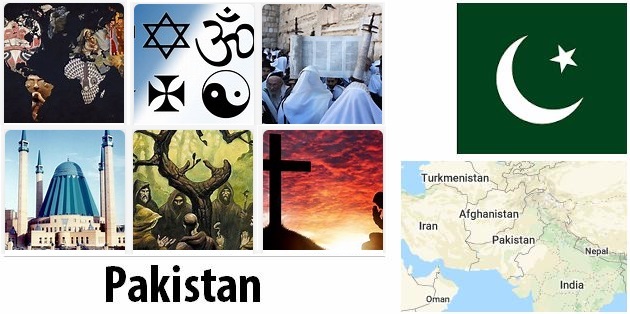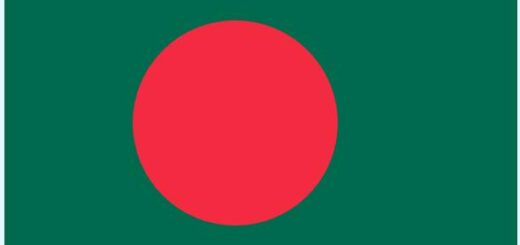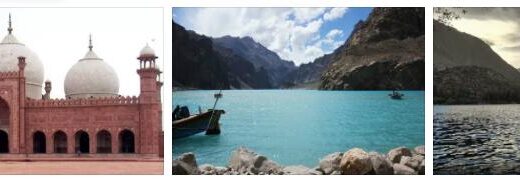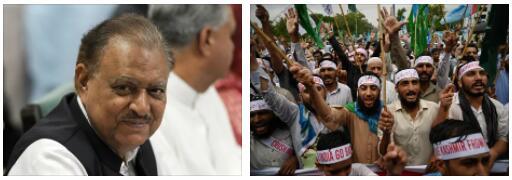Pakistan Religion
Islam itself is the prerequisite for Pakistan’s existence. The country was founded in 1947 to create a home for the Muslims living in colonial India. Nowadays there are strong religious contradictions in society, partly between Shia and Sunni Muslims, and between fundamentalists and more tolerant directions. The country’s strict laws against blasphemy have received criticism from the outside world.
Islam characterizes the everyday life of almost all Pakistanis, and close to one-third of the population is believed to faithfully follow the rules of religion. But while the country’s founders soon saw Islam as a cohesive kit in society, later leaders have strongly emphasized the country’s Islamic character.
Islam is state religion, but the work of introducing Islamic Sharia law as a legal guideline in the 1980s and 1990s led to severe contradictions. By politicizing religion, the rulers created disintegration in society. When the religion was brought from the private world into the public, the relative harmony that prevailed between different religious directions disappeared.
Controversial laws of contempt, Islamist extremism
A number of paragraphs in the Criminal Code prohibit behaviors and statements that may be considered to offend Islam, the Qur’an or the Prophet Muhammad. With reference to these so-called heathen laws, members of religious minorities, sometimes on dubious grounds, have been imprisoned and also sentenced to death. The laws are considered to encourage false declaration for personal or political reasons. No condemned persons have been executed, but a number of convicted – or just accused – persons have been lynched to death by crowds.
In 2011, a governor who criticized the blasphemy laws was shot dead in Islamabad, and in 2014 a Christian couple was falsely accused of forging the Quran. The mob then burned their bodies in a brick oven. When the Supreme Court in 2018 acquitted a Christian woman who had been sentenced to death for blasphemy a decade earlier on questionable grounds in a lower court, this angered the country’s ultra-conservative, who paralyzed Islamabad through mass protests and roadblocks.
The powerful Islamization of society that undermined all regimes in the late 1970s for their own political gain also favored the emergence of violent extremist groups. It was not until Pakistan in the autumn of 2001 that pressure was exerted to join the US-led “war on terror” (see Modern History), the state began to try to stop the activities of extremist movements. But the intervention against extremists has often been half-hearted – an expression of the split in state leadership where important military groups want good relations with certain fundamentalists. Islamic extremists who attack Afghanistan and India have been supported by the Pakistani state.
- Countryaah: Population statistics for 2020 and next 30 years in Pakistan, covering demographics, population graphs, and official data for growth rates, population density, and death rates.
Population composition
Pakistan is a multi-ethnic state. Its residents are descendants of a wide variety of peoples who immigrated to the Indus Valley over the past millennia. Based on the languages spoken in Pakistan, they can be divided into four main population groups.
The Punjabi settle in the Punjab and the surrounding areas. They make up around half of Pakistan’s population.
The Sindhi live in the south of the Indus Valley. Both languages belong to the Indo-Aryan languages.
The Baluch belong to the Iranian peoples, the Pathans resemble the largest ethnic group in Afghanistan, the Pashtuns.
Population distribution
Around 80% of the total population live in the irrigated areas of the industrial lowlands, in the provinces of Sind and Punjab. The rural exodus in Pakistan has continued for decades. The result is slum formation in large cities.
Growth of population
One of Pakistan’s biggest problems is population growth. Between 1970 and 1995, the country’s population almost doubled. Over 50% of the population is younger than 14 years.
After the Afghan war in 1978, an additional 3 million refugees came to the country, mainly in the urban settlements. The big cities like Karachi, but also Lahore and Faisalbad are now big cities. If the education system is poorly developed, the illiteracy rate is 60%. The emigration of academics and well-trained skilled workers is also having a negative impact on the country’s social structure.
Religious minorities are discriminated against
A large majority of the population is Sunnis. A minority of about 20 percent belongs to Islam’s second main religion, Shia. The rivalry between Sunni and Shia has led to a bloody conflict between extreme movements, both of which were formally banned in 2002. Among the Shia Muslims there is the influential branch of the Ismailites, whose head is called Aga Khan. A few percent of Pakistanis confess to ahmadiya, which is a revival movement sprung from Islam but officially labeled as non-Muslim. A member of ahmadiya who calls himself Muslim, or prays Muslim prayers, risks imprisonment for up to three years for blasphemy.
There are also small groups of Hindus, Christians, Buddhists and Parsis (or Zoroastrians) in Pakistan. The latter are supporters of the religion that predominated in Persia (Iran) before Islam. Here also lives a small group of followers of Bahai, a monotheistic religion that grew out of Shia Islam in present-day Iran in the mid-19th century. Religious minorities, which make up about three percent of the population, are often subjected to discriminatory treatment and open violence. Only in the spring of 2018 did Hindus get the right to register their marriage, divorce and remarry.
2012
December
The son Bhutto begins his political career
On the fifth anniversary of the assassination of Benazir Bhutto, her 24-year-old son Bilawal Bhutto Zardari is holding his first public political speech. It is seen as an offshoot of his political career.
Polio vaccinations are discontinued after nine murders
The UN World Health Organization WHO cancels large parts of a nationwide vaccination program against polio after at least nine employees in the project were murdered in Karachi and Peshawar. Taliban have previously threatened the employees of the polio program and are therefore suspected to be behind the murders. The suspicions of the vaccination program arose when it emerged that the US CIA had partially located Usama bin Ladin with the help of a fake vaccination team.
October
Assassination attempt on teenage girl Malala
14-year-old Malala Yousafzai is seriously injured when Taliban in Swat Valley shoot her because of her work to get all girls to go to school. The assassination attempt provokes strong reactions in both Pakistan and the outside world. Conservative religious Muslims in Pakistan are also clearly distancing themselves from the act. Malala is flown to the UK for care.
September
Movie clips about Prophet Muhammad stir up anger
A horror movie clip about the Prophet Muhammad made in the US stirs up the feelings of Muslims around the world as it spreads through the internet and social media. In Pakistan’s major cities, around 25 people are killed in street protests against the movie clip. The Minister of Railways promises a $ 100,000 reward to those who succeed in murdering the author. The government distances itself from the Minister’s proposal.
The power struggle between HD and the government is settled
The government is asking the Swiss authorities to disregard previous instructions that the corruption investigations against Zardari, among others, should be dropped. Thus, the power struggle between the PPP government and HD calms down for the time being.
August
Many Shia Muslims are killed in ambush
About 25 Shia Muslims are killed in ambush against a bus in a mountainous area outside Gilgit city in northern Pakistan. The perpetrators are suspected of being militant Sunni Muslims.
July
The border crossing to Afghanistan opens again
Pakistan reopens border crossings to Afghanistan for NATO transport since US lamented the 24 fatalities required when NATO flight bombed two Pakistani military bases in November 2011.
June
The Supreme Court dismisses Gilani
The power struggle between the Supreme Court (HD) and the Zardari government is intensifying. HD dismisses Prime Minister Gilani, both as head of government and MP. He is succeeded by Raja Pervez Ashraf, who is also a member of the PPP.
May
Prison for help finding bin Laden
A doctor who should have helped the United States find Usama bin Laden is sentenced by a local court to 33 years in prison. The US protests against the verdict and relations between Pakistan and the US deteriorate further.
April
Pakistan test shooter robot
Pakistan fires a medium-range robot – a week after India fires a long-range robot. Pakistani robot Shahin 1-A has a range of up to 300 kilometers, which means it can reach targets in India.
Gilani is sentenced for court-martial
Prime Minister Gilani faces trial for refusing to obey the Supreme Court’s order to appear for interrogation and work to resume corruption investigations in Switzerland (see January 2012). However, the verdict becomes symbolic, as punishment is not imposed and Gilani can remain as prime minister.
January
Gilani is called to a HD interrogation hearing in a corruption business
The government refuses to ask the Swiss authorities to resume a series of corruption investigations against high-ranking Pakistani politicians, including President Zardari, as demanded by the Supreme Court (HD). The court cases include, among other things, a 2003 judgment in which Benazir Bhutto and Zardari were sentenced for money laundering. HD sees the government’s refusal to write to Switzerland as a court battle and orders Gilani to appear in court on January 19 for questioning. The cases were closed in 2007 through an amnesty issued by Musharraf, but this amnesty was annulled by HD in 2009. HD gave the government a deadline until January 16, 2012 to resume the cases.




